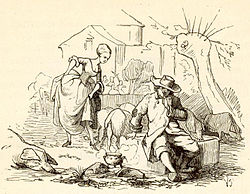| "The Swineherd" | |||
|---|---|---|---|
| Short story by Hans Christian Andersen | |||
 Illustration by Vilhelm Pedersen, Andersen's first illustrator | |||
| Original title | Svinedrengen | ||
| Translator | Charles Boner | ||
| Country | Denmark | ||
| Language | Danish | ||
| Genre | Literary fairy tale | ||
| Publication | |||
| Published in | Fairy Tales Told for Children. New Collection. Third Booklet (Eventyr, fortalte for Børn. Ny Samling. Tredie Hefte) | ||
| Publication type | Fairy tale collection | ||
| Publisher | C. A. Reitzel | ||
| Media type | |||
| Publication date | December 20, 1841 | ||
| Published in English | 1846 in A Danish Storybook | ||
| Chronology | |||
| |||
"The Swineherd" (Danish : Svinedrengen) is a literary fairy tale by Hans Christian Andersen about a prince who disguises himself as a swineherd to win an arrogant princess. The tale was first published December 20, 1841 by C. A. Reitzel in Copenhagen, Denmark in Fairy Tales Told for Children. New Collection. Third Booklet (Eventyr, fortalte for Børn. Ny Samling. Tredie Hefte). The tale appears to be original with Andersen though similar tales are known. "The Swineherd" has been adapted to other media.